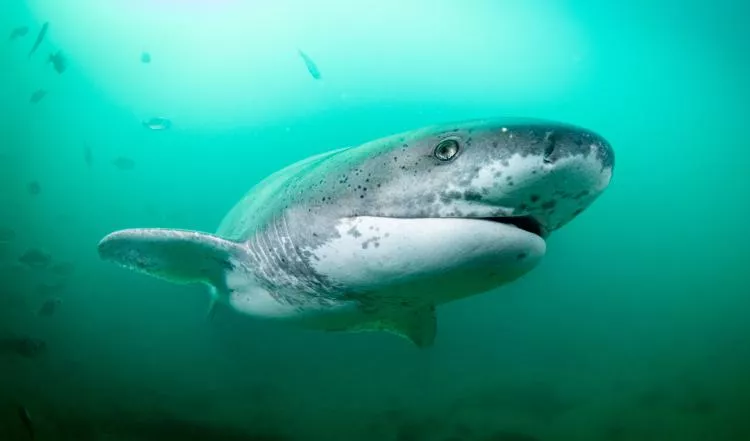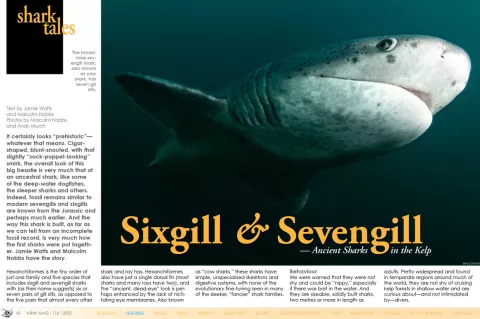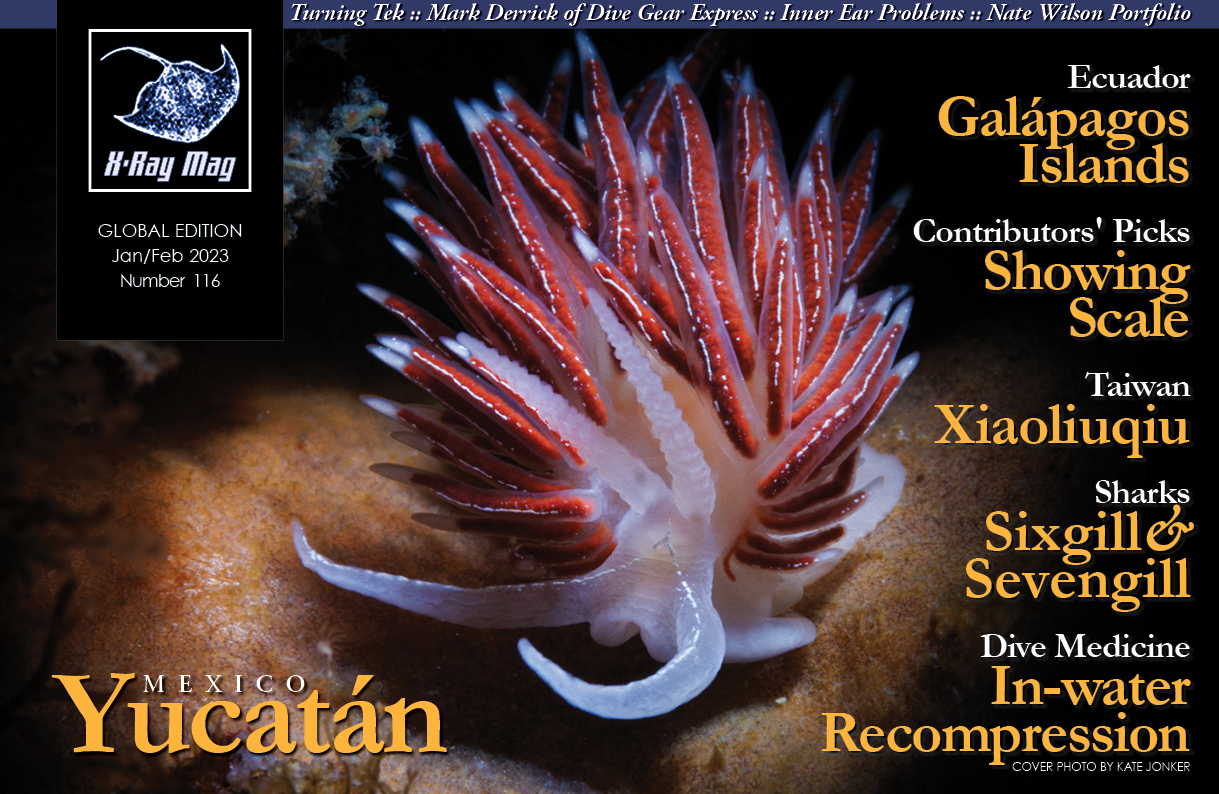It certainly looks “prehistoric”—whatever that means. Cigar-shaped, blunt-snouted, with that slightly “sock-puppet-looking” smirk, the overall look of this big beastie is very much that of an ancestral shark, like some of the deep-water dogfishes, the sleeper sharks and others. Indeed, fossil remains similar to modern sevengills and sixgills are known from the Jurassic and perhaps much earlier. And the way this shark is built, as far as we can tell from an incomplete fossil record, is very much how the first sharks were put together. Jamie Watts and Malcolm Nobbs have the story.
Contributed by
Hexanchiformes is the tiny order of just one family and five species that includes sixgill and sevengill sharks with (as their name suggests) six or seven pairs of gill slits, as opposed to the five pairs that almost every other shark and ray has. Hexanchiformes also have just a single dorsal fin (most sharks and many rays have two), and the “ancient, dead-eye” look is perhaps enhanced by the lack of nictitating eye membranes. Also known as “cow sharks,” these sharks have simple, unspecialised skeletons and digestive systems, with none of the evolutionary fine-tuning seen in many of the sleeker, “fancier” shark families.
Behaviour
We were warned that they were not shy and could be “nippy,” especially if there was bait in the water. And they are sizeable, solidly built sharks, two metres or more in length as adults. Pretty widespread and found in temperate regions around much of the world, they are not shy of cruising kelp forests in shallow water and are curious about—and not intimidated by—divers.
Malcolm found them to be “sneaky sharks, appearing from all points of the compass as well as above and below.” They nibbled on his first stage and camera housing, apparently exploring with their mouths, much like a seal. Not surprisingly, they are frequent scavengers, as well as predators of quite large fishes and invertebrates.
Extra gill slits
A couple of species of rays (of the thousand or so species known) have extra pairs of gill slits, as do three others of the 500 known species of sharks, including the two species of bizarre eel-like and snaggle-toothed frilled sharks, and the sixgill sawshark. Evolutionarily, it is relatively simple to “add” another gill slit. As best as we understand it, one gill slit is simply the appendage that the segmented-wormlike ancestor of all vertebrates had at the sides of its head segments.
Eventually, some of these gill support segments (or something very like them) evolved and differentiated into jaws, jaw supports, spiracles and pectoral and pelvic limb girdles. It does not take much of a genetic change to “add” an extra one—or in the case of the sevengill, two—segments, but it does seem odd that it only happened a handful of times. Evolution seems to have given five as the most successful number.
Where to see them
Of the five members of its family, the broadnose sevengill is by far the easiest for divers to encounter. They come up shallow into temperate kelp forests around much of the world (although not the North Atlantic).
Simons Town in South Africa was long regarded as the best location to see them, although in recent years, orcas moving in to predate these sharks have been blamed for their absence from this area for a couple of years. It appears that they are back, albeit in small numbers.
Three other members of the family are rarely seen by divers, as they spend much of their time below diving depths, and are rather smaller, slimmer and shyer. Then there is the giant of the family, the bluntnose sixgill, which was recently brought to wider public attention by some spectacular footage in the BBC’s Blue Planet II, with some huge specimens jostling with each other and the film crew’s sub while feeding on a whale carcass.
Spending most of their time far deeper than diving depths, bluntnose sixgills can nonetheless be seen in a handful of places in shallow water, and have been encountered on night dives off Vancouver Island for many years.
Sixgill characteristics
Sixgill sharks are one of the biggest non-planktivorous sharks. As adults, they probably average almost the same length as great whites, although nothing as heavily or powerfully built. An adult bluntnose sixgill may weigh half a tonne, with the largest females probably well over a tonne; they are bigger than the largest tiger or hammerhead sharks, and similar in size to the big sleeper sharks.
Like sleeper sharks, these deep-water giants seem to live less active lives than those of the familiar shallow-water requiem or mackerel sharks, probably scavenging more and preying on a range of slower-moving animals, and none of the cow sharks are considered a threat to humans. ■
The sevengill and sixgill sharks photographed for this article were all encountered with Big Fish Expeditions, at Vancouver Island and in South Africa.





























